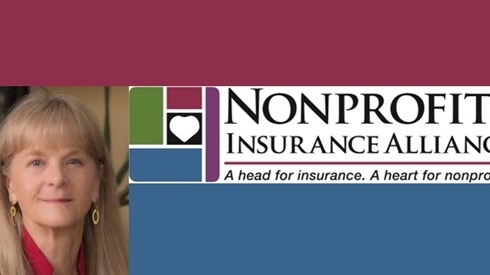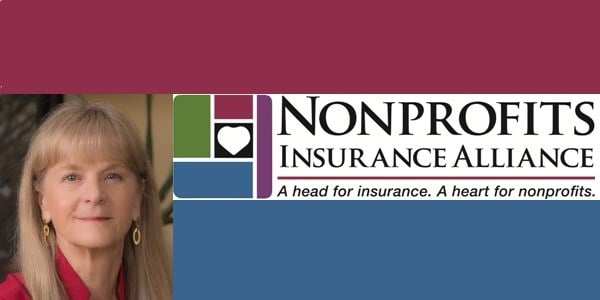A Focus on Pamela Davis and Alliance of Nonprofits for Insurance RRG

March 25, 2019

Captive.com recently spoke with Pamela Davis, the founder, president, and chief executive officer of a group of nonprofit insurers known as the Nonprofits Insurance Alliance. This group includes the Nonprofits Insurance Alliance of California and the Alliance of Nonprofits Risk Retention Group, as well as a captive insurance company and a nonprofit service company. She discusses her work and her views below.
What was the catalyst for the start of the Nonprofits Insurance Alliance (NIA)?
In the mid-1980s, during the extreme capacity shortage in the commercial insurance market, nonprofits could not find liability coverage anywhere. Nonprofits were not well understood, generally paid small premiums, used volunteers, and were considered at high risk for sexual abuse claims. I wrote my master's thesis on the particular problems nonprofits were having obtaining liability insurance and the chilling impact this was having on their ability to deliver social services to many of the most vulnerable in our communities. I asserted that nonprofits were not the poor risks the commercial insurance industry claimed they were and proposed that nonprofits could obtain better coverage and more affordable pricing by jointly insuring themselves. We started first as a risk pool in California, called Nonprofits Insurance Alliance of California, and expanded in 2001 by creating a Risk Retention Group—Alliance of Nonprofits for Insurance, Risk Retention Group—and a captive reinsurer, domiciled in Vermont. The companies as a group are known as the Nonprofits Insurance Alliance.
How has NIA grown since its launch both in terms of number of policyholders and premium volume?
We started with zero policyholders in 1989, a $1 million loan as restricted capital, and $40,000 of working capital. The Loma Prieta earthquake hit the Bay Area when we were moving into our first office, and we were at the epicenter. The first 10 years of operation were very difficult. However, now after 30 years, we insure 18,700 tax-exempt 501(c)(3) nonprofits in 32 states and the District of Columbia. At the end of 2018, gross written premiums were $139.2 million with assets of $530.5 million and surplus of $204.4 million.
To what do you attribute that growth?
Even though there are about 10 commercial insurers claiming to specialize in nonprofits now, they all have their preferred niches and none of them focus on the needs of the small-to-midsized nonprofits like we do. Eighty percent of 501(c)(3) nonprofits have annual budgets of less than $1 million. Most insurers and brokers focus on the other 20 percent. We serve large and small nonprofits equally well and have a robust risk management program for members, most of which is free of charge.
Tell me about the coverages offered to policyholders.
We offer general liability, improper sexual conduct and physical abuse liability, directors and officers liability—including employment practices, social services professional liability, employee benefits liability, business auto liability, nonowned/hired auto liability, liquor liability, and umbrella liability in 32 states and the District of Columbia , only to 501(c)(3) nonprofits. In California , through the risk pool, we also offer businessowners property, auto physical damage, inland marine, and employee/volunteer dishonesty. The risk retention group (RRG) is not presently able , under federal law, to offer property coverages and we use a fronting company in the 31 states for these. We don't insure nonprofits in 18 states because there is no appropriate stand-alone property and auto physical damage available in those states for our members to purchase.
Have the coverages offered to policyholders changed since you started?
We didn't begin offering directors and officers (D&O) insurance until the early 1990s. About 5 years ago , we introduced a new, very low-cost D&O form for nonprofits with only volunteers and no employees. We've enhanced other coverages to make sure we can cover claims that are specific to nonprofits, such as adding volunteers to the dishonesty coverage and as additional insureds on most lines. We also added coverage allowing nonprofits to hire a replacement employee while continuing to compensate an employee placed on leave for an investigation for sexual abuse. Our practice is to write very comprehensive policies so that coverage is available for the claims nonprofits are likely to experience. We are not big on adding bells and whistles that sound impressive but offer coverage nonprofits are unlikely to need.
What advantages does NIA offer to policyholders compared to buying coverage in the traditional market?
It's hard to know where to start here. We are a 501(c)(3) nonprofit like our policyholder-members who elect the board of directors. We offer a vast array of free risk management services, including free and unlimited employment risk management services from our own human resource professionals. We provide a free tool called "BOARDnetWORK" for members to manage their board functions online. We offer direct billing and automatic payments even for those paying the minimum premium of $550. We have had extremely stable pricing over 30 years and have returned nearly $45 million to policyholders in the form of dividends. We have a claims philosophy of looking to find coverage, rather than trying to find a way out of a claim. After all, if we don't cover the claim, our valued member will need to find a way to do so.
What has been your renewal rate?
Our renewal rate has been consistently around 94 percent. The 6 percent that don't renew likely includes about 3 or 4 percent annually of very small nonprofits that let coverage lapse because they suspend operations, at least temporarily. Those who leave for other insurers are likely around 3 percent, and many of those return to us after a couple of years for our service!
What changes lie ahead for NIA?
We are growing at the rate of about 1,200 new members per year. So, growth is definitely expected for the foreseeable future. Also, we recently sold our headquarters to the City of Santa Cruz to make way for new development and are building a net-zero energy use building and expect to move into the new building in early 2020. We have employees in 17 states and are including ample technology in the new building to ensure easy connectivity to staff, brokers, and clients anywhere in the country. Part of that building will include a meeting space for local nonprofits to use free of charge.
You have been involved for many years in the drive to expand the Risk Retention Act to allow RRGs to provide property coverage to their policyholders. Why should Congress expand the law, and what is the likelihood lawmakers will do so?
My work with Congress has been focused on the Nonprofit Property Protection Act. It is a very targeted bill to fix a problem that is specific to small and midsized 501(c)(3) nonprofits. The stand-alone property half of a businessowners policy and auto physical damage policies our members need are not available from commercial insurance companies. Those companies that are willing to insure nonprofits provide the coverage as a bundled package including general liability, sexual abuse, professional, and property all combined. There is only one company in the country offering the property coverage our smaller members need on a stand-alone basis, and it is not economically efficient for them to continue to provide it. We absolutely need to be able to provide these property coverages for our small and midsized member nonprofits. I believe Congress will pass the Nonprofit Property Protection Act because it is a narrow bill that fixes a specific, well-documented market failure and because it is becoming obvious that the opponents don't have reasonable policy objections: they just oppose any change to the status quo and are trying to protect their turf at the expense of little nonprofits.
Many RRGs have closed in recent years. Are you optimistic about the future of RRGs?
RRGs like ours that are laser-focused on providing coverages and services their members need, but that are not well-served by commercial insurance companies, will continue to thrive. As with any company, if an RRG is started for the wrong reasons, has an inadequate market strategy, or is simply not well managed, it will fail. When an RRG fails, critics howl for more regulation. When a licensed, admitted insurance company fails, like what happened recently in California, everyone blames bad luck. The truth is, when an RRG or a commercial insurer fails, it is a failure of regulation. Regulators in all states have the information and the tools they need to stop an RRG before a massive failure. The RRG industry will be even stronger when all domicile regulators take seriously their role of vetting business plans and regulating RRGs as they should and when nondomicile regulators use the ample oversight remedies provided by the Liability Risk Retention Act.
How do you stay up to date on issues?
While I know this industry is changing, I try not to get overwhelmed by the constant buzz about disruption coming at us from all angles. At NIA, we try to stay on the leading edge, but not the bleeding edge, of technology and innovation. I learn from staff about members' and brokers' concerns and always learn a lot when I meet with brokers and nonprofits in person. I also get great input from my board members, most of whom are nonprofit leaders. Our online magazine, Blue Avocado, also helps me stay abreast of the challenges facing nonprofits. Leadership in the insurance industry is still ridiculously white male-dominated, and it is clear to me we are not getting the best decision-making because of that. Hence, I don't feel compelled to follow that crowd.
What have been your most rewarding accomplishments in your time at NIA?
It is tough to pick out just one over the course of 30 years. Certainly, I am proud of shepherding two bills through the California legislature and one through Congress to date to help assure that nonprofits will always have a source of insurance they trust and control. I am also proud that we now have a great database and deep knowledge about nonprofit claims. We will never again be in the position of having commercial insurance companies misrepresenting nonprofits as being too risky to insure. I am also very proud of helping to create a diverse staff and leadership team who care deeply about our mission and who push themselves to make sure we are providing the best possible coverages and services to member nonprofits.
Tell me what you did professionally before creating the companies in NIA?
My first job in the insurance industry was president/CEO/founder of these companies. I grew up in a family who did not value education for women. Before starting NIA , I worked as an administrative assistant, an outdoor educator in Appalachia, a professional handweaver, and the entrepreneur of a natural food store and restaurant in Ohio. I finished my BA at the University of California Santa Cruz in my mid-30s and then completed a master's in public policy at the University of California Berkeley. My graduate thesis was about the extreme difficulties nonprofit organizations were having finding and affording liability insurance. When I completed that degree, I decided to see what would happen if I followed the suggestion my thesis provided to form an insurer owned and governed by the nonprofits it insures. The rest, as they say, is history.
Editor's Note: While lobbying lawmakers is rare for those in the captive insurance industry, Ms. Davis is an exception. Ms. Davis has pressed Congress for many years to expand the Liability Risk Retention Act (LRRA), the federal law that allows the formation of a special kind of captive known as risk retention groups. Unlike other types of captives, RRGs can provide coverage to member-owners after meeting the licensing requirements of just one US state.
There is, however, one catch: RRGs cannot write workers compensation or property coverages.
Ms. Davis has been trying to convince lawmakers to amend the LRRA to allow RRGs to be able to offer property coverage to nonprofits that are unable to find stand-alone property coverage from commercial insurers.
So far, the legislation has been introduced twice in the House but has not passed through committee because some in the industry are opposed.
But that has not discouraged Ms. Davis. Earlier this year, Ms. Davis told Captive.com that small community-based nonprofits "desperately need" this narrow change to the LRRA, adding that she will not stop pressing for this until lawmakers act.
March 25, 2019


